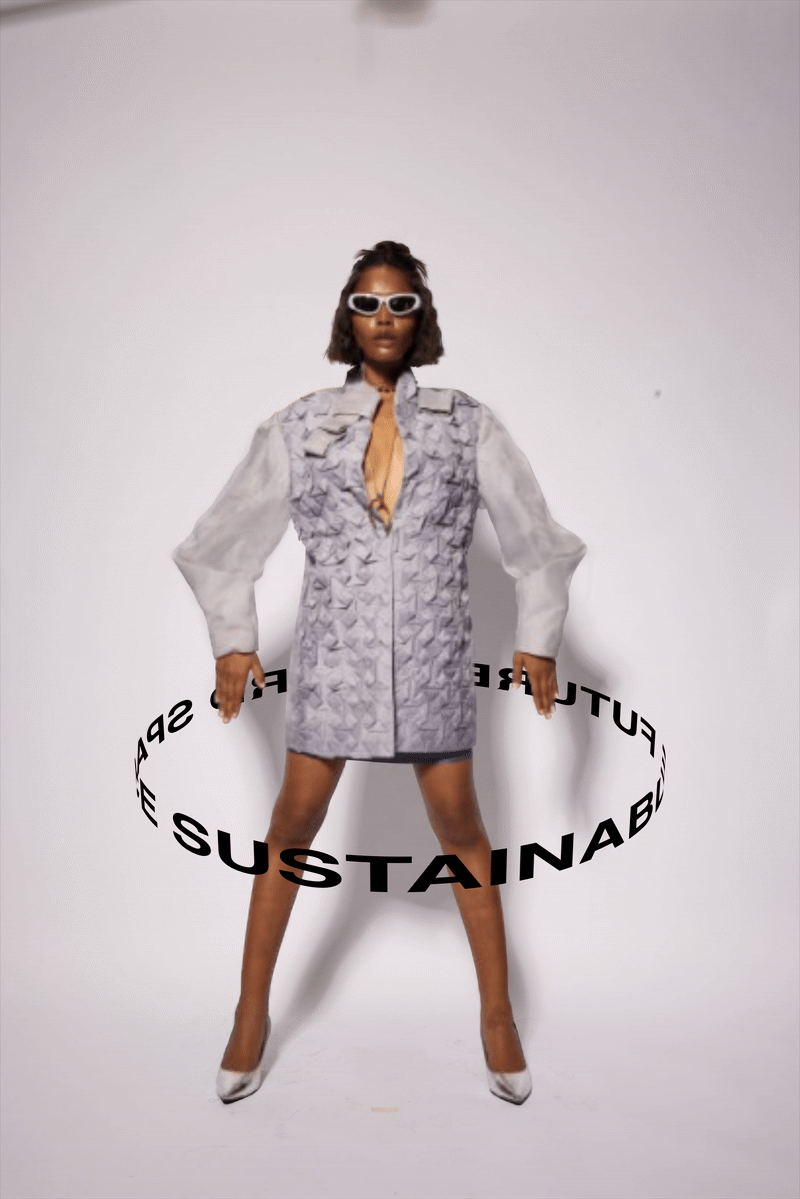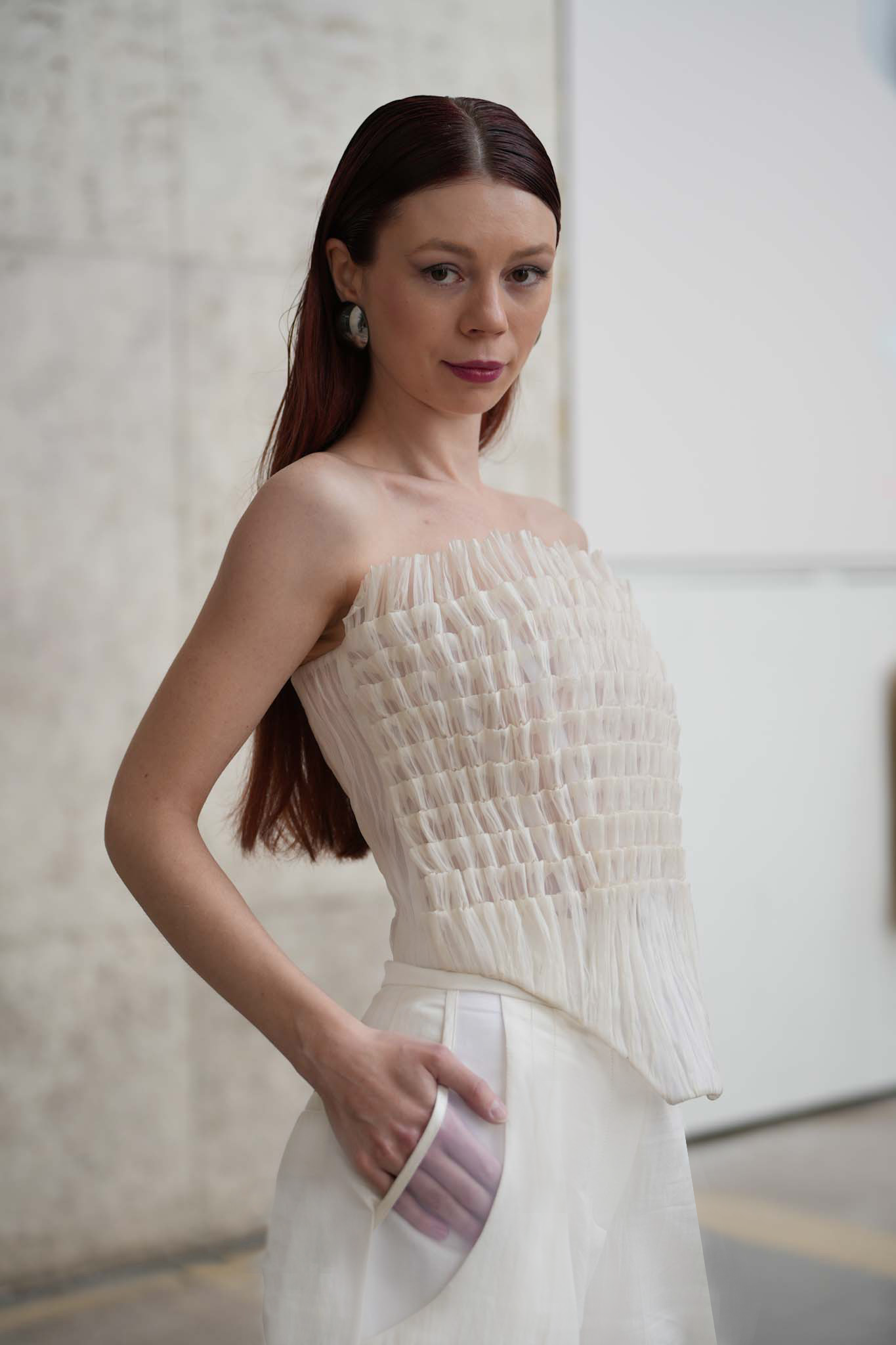SUSTAINABLE PRACTICES BY KRITI GRETA SINGHEE
The Philosophy of Progressive Luxury
At the heart of Kriti Greta Singhee lies a deep commitment to progressive luxury—where sustainability, ethics, and artistry come together to shape a better future. The brand is rooted in the belief that fashion should not only celebrate beauty and heritage but also protect the planet and uplift communities.
“Sustainability” is not just a choice but the “core philosophy” guiding every facet of the brand—from design to production. Each garment is an embodiment of slow fashion values, combining timeless elegance with eco-conscious innovation. Through handwoven fabrics, organic materials, and artisanal techniques like weaving, hand dyeing, and intricate pleating (plissé), Kriti Greta Singhee crafts silhouettes that are both enduring and environmentally responsible.
Sartorial Craft Meets Ethical Values
Kriti Greta Singhee embraces the philosophy of progressive luxury. Sustainability and ethical fashion practices are what we believe in. The brand creates a positive impact on the environment and people. The core vision is the commitment to sustainability, honesty, and responsibility in creating a better future while protecting the earth and standing in solidarity with all people. Sustainability is an integral part of the brand’s core values. Kriti Greta Singhee creates timeless silhouettes with sartorial twists and exquisite artistic techniques such as weaving, artisanal hand dyeing, and intricate hand pleats, or ‘plissé.’ Timeless, pared-down designs are presented in various hues, textures, and eco-conscious materials. The brand uses organic materials and considers the carbon footprint of the manufacturing process, aiming for climate neutrality or positivity. In response to escalating environmental concerns, the brand believes deeply in sustainable practices, incorporating eco-friendly materials, ethical sourcing, and circular processes to minimize waste and reduce carbon footprints. The brand’s ethical practices and transparency are directed toward creating a more sustainable environment for a conscious and aware consumer. Sustainable materials include handwoven fabrics and textiles with hand-spun natural fibers from specific craft clusters in India, like Fulia in West Bengal, Kashmir, and Rajasthan. The designer works closely with communities, artisans, and weavers from these clusters. Natural and organic fabrics such as banana, hemp, muslin, various types of mulberry silk, tissues, cashmere, and organza in different counts are also experimented with. The designer’s philosophy is to create meaningful clothing that pays tribute to Indian heritage and culture in the changing contemporary world, while also being sustainable and mindful of environmental impact and climate change. Kriti Greta Singhee aims to uplift artisans and society as a whole through individual, artistic, and altruistic approaches, embracing the philosophy of progressive luxury. This collaborative effort not only preserves the heritage and skills of artisans but also provides sustainable livelihoods and helps alleviate poverty in certain regions. Working with artisans who use, conserve, and preserve traditional techniques and craftsmanship to create exquisite pieces is essential to the brand’s vision.

Certified Sustainability and Conscious Creation
The designer holds ample room for innovation, shaping design that aligns with environmental responsibility and ethical and fair working practices. The process implemented by Kriti Greta Singhee—from the procurement of natural yarns to hand-weaving at craft clusters, fabric manipulation by hand, and impeccable tailoring—involves sustainability at every stage of manufacturing. Artisanal methods are used for dyeing textiles with eco-friendly colors. The threads used for tailoring and the fabrics created and sourced are certified with international standards such as Oeko-Tex Standard Certification, GOTS, GRS, and others compliant with REACH, the “4 Sustainability ZDHC Program,” and more. Certified fabrics like recycled tulle, cotton, silk, nylon, and polyester are also used. Leather cords and other materials from scrapyards, along with recycled waste from scrap markets, are transformed into sculptural embellishments—giving them a new life.
Designing for Longevity and the Planet
The plissé technique is a sustainable process pertaining to slow fashion that creates unique, wearable art that increases the longevity of the textile while keeping trends and eco-conscious values. Waste reduction and a lower carbon footprint are key concerns for the brand. Kriti Greta Singhee implements various strategies, such as using local production to reduce transportation emissions, designing products that are made to last, and even offering repair services to extend the lifespan of the clothing. This approach not only benefits the environment but also ensures that consumers invest in products centered around longevity. In terms of longevity, the brand also implements hand techniques and processes in terms of plissé or hand pleating or other hand embellishments made from recycled scrap materials. The brand’s timeless silhouettes are elevated with sartorial twists and intricate, artisanal techniques like weaving, hand-dyeing, and the delicate art of hand pleating (plissé). These pieces are designed to be ageless, blending pared-down elegance with eco-conscious materials that embody the brand’s commitment to sustainability. The brand vision is to redefine simplicity and consumerism with a conscience. Kriti Greta Singhee uses and creates a variety of eco-friendly materials, quality eco-conscious materials and processes, and even works to reduce waste by repurposing and recycling. This commitment to sustainable materials not only benefits the environment but also ensures that the end product is of the highest quality. The brand value aims to reflect upon changing consumer values and the growing awareness of environmental and ethical fashion. It is a shift towards a more mindful and responsible approach to luxury consumption. Varieties of natural paper are used for the packaging of the brand.
A Transparent, Circular, and Ethical Model
Sustainability is deeply ingrained in the core values of Kriti Greta Singhee’s brand philosophy. It serves as the foundation for every collection, guiding both design and production processes. Ethical and progressive luxury embodies a commitment to transparency, social responsibility, and environmental stewardship, challenging the narrative that extravagance must come at the cost of ethical considerations. The brand strives to harmonize heritage, modernity, craftsmanship, and contemporary culture, creating garments that are as environmentally responsible.The entire manufacturing process is carefully considered to minimize carbon emissions and waste. The brand actively works towards achieving climate neutrality, with a focus on circular fashion practices that ensure garments can be recycled or repurposed at the end of their lifecycle. Ethical sourcing and transparent production processes are fundamental to the brand’s mission, ensuring that every piece contributes to a more sustainable and ethical world. Kriti Greta Singhee’s approach to sustainability is not just about creating eco-friendly fashion but about fostering a conscious consumer culture. The brand’s transparency is in all its practices while offering consumers a deeper connection to the clothing they wear, encouraging a more mindful approach to fashion and a greater awareness of the impact of our choices aimed at creating a better planet. By integrating sustainable materials, ethical sourcing, and circular production methods, Kriti Greta Singhee believes we can move toward a more responsible future for fashion. Each piece is not just a garment but a reflection of the brand’s unwavering commitment to preserving both heritage and the environment for future generations.
A Movement Towards a More Conscious Luxury
Kriti Greta Singhee redefines luxury for the modern world—where beauty is responsible, consumption is conscious, and fashion is a force for good. The brand harmonizes heritage and modernity, weaving a narrative that honors tradition while embracing innovation. Rooted in values of human rights, gender equality, and environmental stewardship, the brand’s ultimate vision is to reshape the future of fashion—one that is ethical, inclusive, and deeply sustainable. Each creation is not just a garment—it’s a statement of intent, a celebration of culture, and a commitment to the planet.
